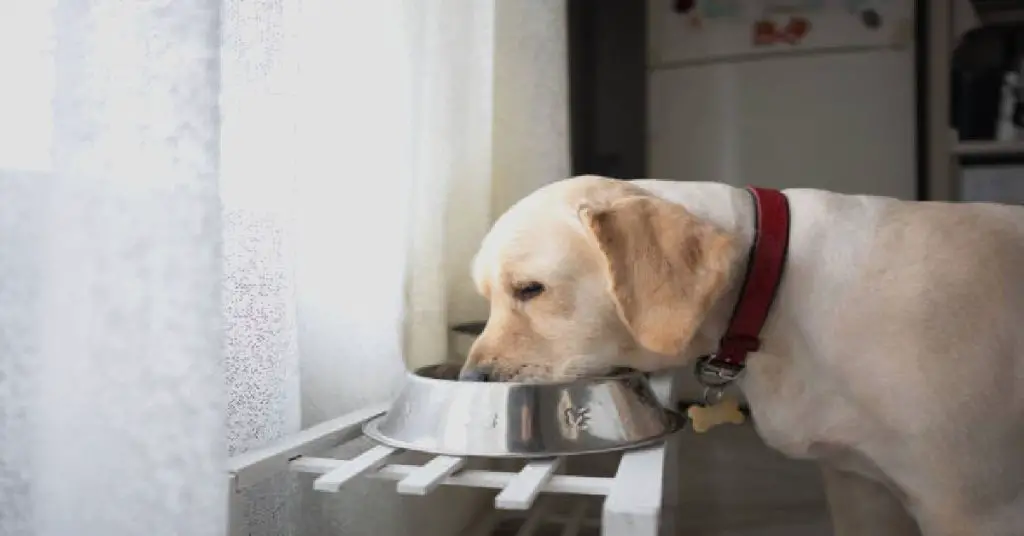A dog bowl should be at an appropriate height for the dog to eat comfortably without straining its neck or back muscles. Placing the bowl at a height that allows the dog’s front legs to be in a straight position is recommended to promote good posture and digestion.
Moreover, ensuring the bowl is at the correct height can also minimize the risk of bloat, a potentially life-threatening condition. By considering the dog’s size and breed, you can determine the most suitable height for the bowl. Providing a raised or elevated feeder can be beneficial for larger dogs to avoid excessive bending and straining, while smaller dogs may require a lower bowl placed at ground level to ensure proper eating posture.
Optimal Height For Dog Bowls
When it comes to feeding your furry friend, you may not give much thought to the height of their food and water bowls. However, the elevation of these bowls plays a vital role in your dog’s overall health and well-being. In this article, we will explore the importance of correct bowl elevation and how it can impact your dog’s posture and digestion.
Importance Of Correct Bowl Elevation
Choosing the right height for your dog’s bowls is crucial for several reasons. It not only ensures their comfort during meals but also promotes proper digestion and minimizes the risk of certain health issues. Bowls that are too low or too high can lead to physical strain and discomfort for your dog. Inadequate elevation can cause your dog to have to stretch their neck or bend too far down to reach their food, which can lead to strain on their muscles and joints.
On the other hand, bowls that are too high can force your dog to stretch their neck upward, causing tension and potential discomfort in their throat and esophagus. Moreover, the optimal bowl height promotes a healthier eating posture for your dog. When your dog’s bowls are set at the correct height, their spine remains aligned, offering them a more natural and relaxed position while eating or drinking. This is particularly important for older or arthritic dogs, as it reduces strain on their joints and decreases the risk of injury.
Effects On Dog’s Posture And Digestion
The elevation of your dog’s bowls can have a significant impact on their posture and digestion. Improper bowl height can result in your dog gulping air while eating, leading to problems such as bloating, indigestion, and increased risk of gastric torsion (also known as bloat). When a dog eats from a bowl that is too low, they are more likely to swallow air along with their food. This can cause their stomach to fill with gas, leading to discomfort and potentially dangerous conditions. On the other hand, bowls set at the appropriate height encourage slower and more regulated eating, minimizing the risk of bloat and aiding in proper digestion.
Furthermore, improper bowl height can contribute to several orthopedic issues. Dogs that have to strain their necks or hunch over to reach their food may develop musculoskeletal problems such as neck, shoulder, or back pain. By ensuring the right bowl elevation, you can help prevent these issues and ensure your dog’s long-term musculoskeletal health. In summary, choosing the optimal height for your dog’s bowls is essential for their overall well-being. It promotes a comfortable eating posture, reduces strain on their muscles and joints, aids in proper digestion, and minimizes the risk of related health issues. Take the time to find the right bowl height for your furry friend, and you’ll be rewarded with a happy and healthy companion.
Assessing Your Dog’s Size
When it comes to feeding your furry friend, it’s important to consider their comfort and well-being. One factor to keep in mind is the height of their food bowl. The proper height can make mealtime more enjoyable for your dog, reducing strain on their neck and joints. So, how high should a dog bowl be? Assessing your dog’s size is the first step in determining the right height for their feeding station. Let’s explore the important factors to consider: breed, height, and health.
Factors To Consider: Breed, Height, And Health
Each dog breed has its own unique characteristics, including size and body structure. These factors play a crucial role in determining the optimal height of your dog’s food bowl. Here are some points to consider:
- Breed: Different breeds have different average heights and body types. For example, small breeds like Chihuahuas generally have shorter legs compared to larger breeds like Great Danes. Understanding your dog’s breed-specific traits will help you determine a suitable bowl height.
- Height: Measuring your dog’s height from the ground to their shoulder can give you a baseline for estimating the bowl height. A taller dog may require a raised bowl compared to a shorter one.
- Health: It’s crucial to take your dog’s health into account when determining the bowl height. Dogs with conditions like arthritis or neck problems may benefit from a higher bowl to reduce strain and discomfort during mealtimes.
Height Chart Guide By Dog Size
Below is a helpful height chart guide based on the average height of different dog sizes. Keep in mind that individual dogs within a size category may vary, so it’s important to consider your specific dog’s needs.
| Dog Size | Height (in inches) | Recommended Bowl Height (in inches) |
|---|---|---|
| Small | 10-14 | 2-4 |
| Medium | 15-20 | 6-8 |
| Large | 21-25 | 10-12 |
| X-Large | 26 and above | 12 and above |
Remember, these are just general guidelines to help you determine a starting point. It’s essential to observe your dog’s comfort and eating habits with the new bowl height. If any discomfort or difficulties arise, make the necessary adjustments. Taking the time to assess your dog’s size and specific needs will ensure a comfortable and enjoyable mealtime experience for your beloved companion.
Customizing Bowl Height
When it comes to feeding your furry friend, it’s important to consider the height of their bowl. The proper bowl height plays a crucial role in their digestion and overall comfort during mealtime. One size does not fit all when it comes to dogs, as their size, breed, and health conditions can vary greatly. Customizing the height of your dog’s bowl is key to ensuring they are happy and healthy. In this article, we will explore different methods for customizing bowl height, from DIY solutions for adjustable stands to purchasing adjustable feeders.
Diy Solutions For Adjustable Stands
If you’re a hands-on pet owner looking for a budget-friendly option, creating your own adjustable bowl stand can be a fun project. There are several simple DIY ideas for making an adjustable stand that suits your dog’s specific needs. Here are a few:
- Use wooden blocks or bricks: Stack a few wooden blocks or bricks to create an adjustable stand. You can easily add or remove blocks to find the right height. Make sure the stand is stable and secure, so it doesn’t tip over during mealtime.
- Retrieve old furniture: Take a look around your home or visit a thrift store for old, unused furniture that can be repurposed as a bowl stand. Desks, small shelves, or side tables can be modified to fit the height you desire. Sand and paint them to match your home decor.
- Get creative with adjustable materials: Explore items such as PVC pipes, adjustable curtain rods, or even bed risers to create an adjustable stand. These materials are readily available, affordable, and easy to customize according to your dog’s needs.
Purchasing Adjustable Feeders
If you prefer a more convenient option, purchasing an adjustable feeder is a fantastic solution. Adjustable feeders are designed specifically to accommodate different dog sizes and requirements. They typically come with adjustable legs or a sliding mechanism that allows you to customize the height of the bowl. Here are a few factors to consider when purchasing an adjustable feeder:
- Sturdiness: Ensure the feeder is stable and not prone to tipping over, especially if you have an energetic or large breed dog.
- Material: Look for a feeder made from durable materials such as stainless steel or BPA-free plastic. These materials are easy to clean and maintain, ensuring your pet’s meals are served in a safe and hygienic environment.
- Ease of adjustment: Opt for a feeder with a user-friendly adjustment mechanism. This will make it effortless to find the perfect height for your furry friend without any hassle.
- Size options: Consider the size options available, as different feeders cater to different dog sizes. Measure your dog’s height at the shoulder and choose a feeder that allows them to eat comfortably without straining their neck or joints.
Choosing the right bowl height for your dog is important to promote proper digestion and prevent strain on their neck and back. Whether you opt for a DIY solution or decide to purchase an adjustable feeder, customizing the bowl height will ensure your fur baby can enjoy their mealtime to the fullest.
When ‘how High Should A Dog Bowl Be’ Matters
When it comes to feeding our beloved pets, there are various factors to consider to ensure their well-being and comfort. One important aspect to take into account is the height of their food bowls. Many pet owners may not realize the significance of this, but ‘how high should a dog bowl be’ does indeed matter.
Specific Cases: Puppies To Seniors
Puppies and senior dogs have different needs when it comes to their food bowls. For puppies, their small stature necessitates a lower bowl height, making it easier for them to reach their food and water. A bowl that is too high may discourage them from eating or drinking properly, which could potentially affect their growth and development. In contrast, senior dogs often face various age-related issues such as arthritis or joint stiffness. For them, a raised bowl can alleviate strain on their neck and back, making mealtime more comfortable and enjoyable. This uplifted position reduces the need for them to bend down, reducing the potential for pain or discomfort that may discourage them from eating.
Health Conditions Requiring Elevation
Some dogs may have specific health conditions that call for elevated food bowls. One such condition is gastric dilatation-volvulus, more commonly known as bloat. This serious condition involves the stomach filling with gas or twisting, which can be life-threatening if not treated promptly. If your dog is prone to bloat or has already experienced this condition, investing in an elevated bowl is highly recommended. Eating from an elevated height can help reduce the chances of swallowing excessive air, which is one of the factors contributing to bloat.
This preventive measure can potentially save your dog’s life. Additionally, dogs with certain neck or spine issues may benefit from raised food bowls. This includes breeds with a predisposition to intervertebral disc disease or those recovering from neck or spinal injuries. An elevated bowl minimizes strain on their neck and spine, promoting healing and reducing discomfort during mealtime. Ensuring the right height for your dog’s food bowl is crucial for their overall health and well-being. Understanding the specific needs of puppies, senior dogs, and those with health conditions requiring elevation empowers pet owners to make informed choices. By providing the right bowl height, optimal comfort and improved mealtime experiences can be achieved for our furry friends.
Elevated Feeding Pros And Cons
Discover the pros and cons of elevated feeding for dogs and find out the ideal height for a dog bowl. Improve your pup’s eating experience while considering the potential benefits and drawbacks of elevated feeding.
Advantages For Digestion And Joints
One of the main benefits of elevated feeding bowls for dogs is the positive impact it can have on their digestion and joint health. When dogs eat from a bowl that is placed at a suitable height, it promotes better posture and reduces the strain on their neck and back muscles. This is particularly beneficial for dogs with certain health conditions, such as arthritis or back problems. Proper alignment of the digestive tract is another advantage of elevated feeding.
By lifting the food and water bowls to a comfortable height, it helps to prevent strain on the dog’s neck and allows for better swallowing and digestion. When dogs eat from a raised position, gravity assists the food in moving smoothly through the esophagus into the stomach, reducing the chances of gastrointestinal issues, such as bloating or excessive gas. Elevated feeding bowls can also be especially helpful for larger breed dogs that are more prone to developing digestive issues or suffering from joint problems as they age. By reducing the amount of bending and stooping required to eat or drink, these types of bowls can make mealtime more comfortable and enjoyable for our furry friends.
Counterarguments And Potential Issues
While there are several advantages to using elevated feeding bowls for dogs, it is important to consider potential counterarguments and issues as well. Some pet owners may argue that elevated feeding can lead to a higher risk of bloat, a condition in which the stomach twists and fills with gas. However, studies have shown that the risk of bloat is more related to factors such as the dog’s breed, eating habits, and the type of food they consume, rather than the height of the feeding bowl. It is always best to consult with a veterinarian to determine if elevated feeding is suitable for your specific dog.
Another potential issue with elevated bowls is that they may not be suitable for all dogs. Certain breeds, such as those with short legs or flat faces, may find it more challenging to access food and water from a raised position. Additionally, some dogs may be reluctant to adapt to a new feeding height and may initially resist using elevated bowls. In summary, while elevated feeding bowls can offer numerous benefits for digestion and joint health, it is important to consider potential counterarguments and individual dog’s requirements before making a decision. Consulting with a veterinarian can provide valuable guidance and ensure that the feeding arrangement you choose is the best fit for your beloved canine companion.
Choosing The Right Bowl Material
Choosing the right bowl material is important to ensure your dog’s comfort while eating. Consider how high the dog bowl should be to prevent any strain on their neck and shoulders. Opt for a bowl that is at a height suitable for your dog’s size and breed to promote better digestion and overall well-being.
Intersection Of Height And Materials
When it comes to choosing the right bowl material for your furry friend, considering the height of the dog bowl is equally important. The height at which your dog eats and drinks can have a significant impact on their comfort, digestion, and overall well-being. It’s essential to strike the right balance between the height and the material of the dog bowl to ensure your pet’s optimal dining experience.
Safety And Durability Considerations
Ensuring the safety and durability of your dog’s bowl is paramount. After all, you want a bowl that can withstand daily wear and tear, as well as any accidental knocks or drops. Additionally, safety is of utmost concern to keep your dog protected from any harmful substances or chemicals that might leach from low-quality materials. Here are some key considerations when it comes to safety and durability:
- BPA-free and non-toxic materials: Look for dog bowls made from BPA-free and non-toxic materials, such as stainless steel, ceramic, or food-grade silicone. These materials are not only safe for your dog but also durable and easy to clean.
- Puncture and chew-resistant: Dogs can be notorious for chewing or scratching their bowls. Opt for materials like stainless steel or ceramic that are puncture and chew-resistant to avoid any potential hazards.
- Sturdy construction: Ensure that the bowl is well-constructed with a solid base to prevent tipping or sliding. This will not only reduce the mess but also provide stability for your pet during mealtime.
It’s critical to prioritize safety and durability when selecting the right bowl material for your furry friend. By doing so, you can ensure a long-lasting and enjoyable dining experience for your dog, while also providing you with peace of mind.
Integration With Home Design
When it comes to creating a harmonious and visually appealing living space, every detail matters. This includes your furry friend’s feeding area. Integrating your dog’s bowl with your home design not only enhances the overall aesthetic but also ensures functionality. Let’s explore how you can blend style and practicality with elevated feeding stations for your furry companion.
Blending Functionality And Aesthetics
Creating a seamless integration between your dog’s bowl and your home design is all about finding the perfect balance between functionality and aesthetics. The last thing you want is a clunky and unsightly feeding station that stands out like a sore thumb. Instead, opt for an elevated dog bowl that complements your interior style while offering convenience both for you and your furry friend. Here are some key features to consider when choosing an elevated feeding station:
- Elegant design: Look for a feeding station that matches the overall style of your home. Whether your interior is modern, rustic, or eclectic, you can find elevated bowls in various designs, materials, and finishes that seamlessly blend with your existing decor.
- Space-saving solution: If you’re tight on space, opt for a compact and well-designed elevated feeding station. These space-saving solutions not only elevate your dog’s bowl to a comfortable height but also come with built-in storage compartments, eliminating clutter and maximizing functionality.
- Adjustable heights: Dogs come in all shapes and sizes, so it’s crucial to choose an elevated bowl that can be adjusted to the appropriate height for your furry friend. This allows for proper digestion and reduces strain on their neck and joints.
Remember, the goal is to create a visually pleasing feeding area that seamlessly integrates with your home design. So, take your time to explore different options and consider the specific needs of your dog and your household.
Space-saving Elevated Feeding Stations
One of the greatest advantages of incorporating elevated feeding stations into your home design is their space-saving nature. These specialized designs not only provide a comfortable dining experience for your furry companion but also keep your living space organized and clutter-free. Here are some benefits of space-saving elevated feeding stations:
- Efficient use of limited space: If you live in a small apartment or have a compact kitchen, an elevated feeding station with built-in storage can be a game-changer. This clever design allows you to keep your dog’s food, treats, and accessories neatly tucked away, saving valuable floor and countertop space.
- Clean and tidy appearance: No one wants feeding bowls and pet-related supplies scattered around the house. With a space-saving elevated feeding station, everything has its designated place, creating a clean and tidy look while ensuring easy access to your dog’s essentials.
- Functional and versatile: Some space-saving elevated feeding stations offer additional features like foldable legs or removable tray inserts, making them portable and easy to clean. This versatility adds convenience to your daily routine, especially if you and your furry friend are always on the go.
By seamlessly integrating a space-saving elevated feeding station into your home design, you not only enhance the aesthetic appeal but also optimize your living space, making it more efficient and organized.
Preventing Food Spill Problems
When it comes to feeding your furry friend, finding the right height for their dog bowl is crucial. One common problem dog owners face is food spills, which can create a messy and unhygienic feeding area. Luckily, there are solutions available to minimize these spill problems and keep your dog’s feeding area clean. In this section, we will discuss designs that are specifically created to prevent food spills and the maintenance steps needed to ensure your elevated dog bowl is spill-free.
Designs That Minimize Mess
The right design choice can greatly minimize the risk of food spills during your dog’s mealtime. Here are a few designs to consider:
- Wide base and anti-slip features: Look for a dog bowl with a wide and stable base. This design feature prevents accidental tipping when your pup gets a little too excited during mealtime. Additionally, anti-slip features like rubberized bottoms offer extra stability and prevent bowl movement.
- Side walls and raised edges: Dog bowls with elevated side walls and raised edges can help contain any spills. These designs create a barrier that prevents kibble or water from spilling over the sides. Choose bowls with high sides that suit your dog’s eating style and size.
- Multiple compartments: Some elevated dog bowls come with multiple compartments, allowing you to separate food and water. This design helps prevent mess by minimizing the chances of food falling into the water bowl, reducing the risk of contamination and spills.
Maintenance Of Elevated Dog Bowls
Maintaining your dog’s elevated bowl is essential for preventing food spills. Here are a few steps to ensure a spill-free feeding area:
- Regular cleaning: Clean the bowl after each meal to remove any leftover food particles or residue. Use mild dish soap and warm water for effective cleaning. This practice not only maintains hygiene but also prevents the buildup of old food that could potentially spill.
- Secure placement: Ensure that the elevated dog bowl is placed on a stable surface. Avoid placing it in high-traffic areas to prevent accidental bumps or knocks that can lead to spills. Find a dedicated spot for your dog’s feeding area, providing a stable and undisturbed place for their meals.
- Monitor portion sizes: Avoid overfilling the bowl with kibble, as it can easily get knocked out or spilled. Monitor your dog’s portion sizes according to their dietary requirements and adjust as needed.
By selecting a dog bowl with spill-preventing designs and following proper maintenance routines, you can significantly minimize food spill problems. Not only will this keep your dog’s feeding area clean and hygienic, but it will also provide a stress-free mealtime experience for both you and your furry companion.
Frequently Asked Questions
How High Should A Dog Bowl Be?
The height of a dog bowl should be at the level of your dog’s chest to promote proper digestion and avoid strain on their neck and shoulders.
What Is The Ideal Height For A Dog Bowl?
The ideal height for a dog bowl is typically around 2-3 inches from the ground, allowing your dog to eat comfortably without needing to stretch too much or lower their head too far.
Why Is It Important To Consider The Height Of A Dog Bowl?
Considering the height of a dog bowl is important to prevent your furry friend from developing digestive issues, neck strain, or discomfort while eating or drinking.
Can The Height Of A Dog Bowl Impact My Dog’s Health?
Yes, the height of a dog bowl can impact your dog’s health. If it’s too low or too high, it can lead to digestion problems, bloating, neck pain, or even contribute to the development of a condition called megaesophagus.
How Can I Determine The Right Height For My Dog’s Bowl?
To determine the right height, measure your dog’s height from the ground to their chest and subtract a few inches to find the optimal bowl height that will allow them to eat comfortably and maintain good posture.
Conclusion
Choosing the right height for your dog’s bowl is essential for their comfort and overall health. By considering your dog’s breed, size, and potential health issues, you can determine the optimal height. Whether you opt for an elevated bowl or a raised platform, ensuring that your furry friend can eat and drink comfortably will contribute to their overall well-being.
Don’t forget to consult with your veterinarian for personalized advice tailored to your dog’s specific needs.
Related posts:
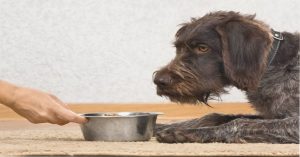 What to put in dog bowl to slow eating
What to put in dog bowl to slow eating
 what Is The Best Dog Food For Dogs With Allergies?
what Is The Best Dog Food For Dogs With Allergies?
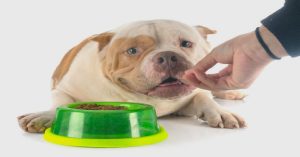 Dog Pushing Food Bowl Away With Nose | Understand The Behavior
Dog Pushing Food Bowl Away With Nose | Understand The Behavior
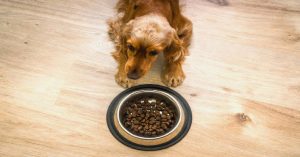 Why Does My Dog Knock Over His Food Bowl? Understanding Canine Behavior
Why Does My Dog Knock Over His Food Bowl? Understanding Canine Behavior
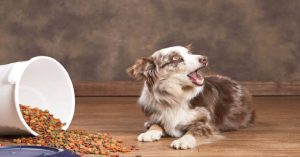 Why Does My Dog Dump His Food Bowl Over? Tips to Stop it
Why Does My Dog Dump His Food Bowl Over? Tips to Stop it
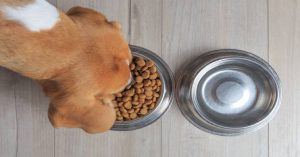 Dog Bowls That Cannot Be Tipped Over | Solution for Messy Eaters
Dog Bowls That Cannot Be Tipped Over | Solution for Messy Eaters

